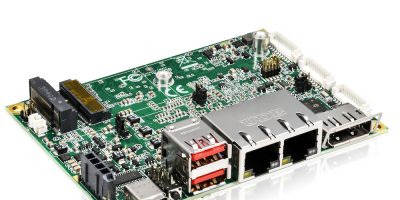Kontron has announced its new 2.5” Single Board Computer (Pico-ITX SBC) product line with the new 2.5”-SBC-AML/ADN. This board offers a compact and portable computing solution with enhanced processing and graphics performance, faster AI inference capabilities, low power consumption, and low latency. The new SBCs are ideal for critical real-time computing in industrial automation, smart cities, energy, retail, and healthcare applications. Samples will be available to customers in November 2024.
The 2.5”-SBC-ADN and 2.5”-SBC-AML support standard or project-based all variants of low-power Intel Atom x7000E Series, Intel Core i3 N-Series, Intel N-Series (codenamed Alder Lake N) and Intel Atom x7000RE Series (code name Amston Lake) processors. These boards feature integrated Intel UHD Graphics (Gen12), AI acceleration, and real-time computing capabilities. The new Pico-ITX Single Board Computers provide multiple embedded controller features and advanced technology components, delivering nearly double (compared to the previous generations) graphics performance with up to 32 execution units in the iGPU for concurrent AI inference workloads. Combined with the Intel® Deep Learning Boost, the new SBC offer faster AI inference performance.
Despite its compact size of just 100 mm x 72 mm – slightly larger than a credit card – 2.5”-SBC-ADN and 2.5”-SBC-AML deliver impressive graphics and media processing power. They support three 4K displays at 60 fps through an internal eDP interface and two external connectors: DisplayPort and DisplayPort over USB-C.
The 2.5”-SBC-ADN and 2.5”-SBC-AML feature advanced components, including in-band ECC-enabled LPDDR5 soldered SDRAM (4, 8, or 16 GB) with speeds up to 4800 MHz, two 2.5 GbE LAN Intel I226 controllers, and three USB 3.2 Gen 2 connectors (Type A and Type C) at up to 10 Gbps. These components enable ultra-low latency within the system and with peripheral devices. Additionally, some variants support Intel Time Coordinated Computing (TCC) and Time-Sensitive Networking (TSN), providing real-time responsiveness with up to 1 microsecond accuracy over Ethernet.
The soldered eMMC storage (32 GB, 64 GB, or 128 GB), together with mounted LPDDR5, make 2.5”-SBC-ADN and 2.5”-SBC-AML resistant to shock and vibration. 2.5”-SBC-AML is specifically designed for continuous 24/7 operation in harsh environments and high system loads. Both Single Board Computers are available in commercial (0 °C to 60 °C) and industrial (-40 °C to 85 °C) temperature variants to suit different applications.
The 2.5”-SBC-ADN and 2.5”-SBC-AML support a wide input voltage range (DC 9 V to 20 V) for unstable power supplies. Additionally, a discrete TPM 2.0 security chip enhances user authentication, network access, and data protection compared to firmware TPM.
Despite its small footprint, the 2.5”-SBC-ADN and 2.5”-SBC-AML offer robust connectivity and expansion options, including two internal COM ports (two RS232 or two RS232/422/485) and eight digital I/O channels for industrial applications. The boards feature two M.2 expansion slots (Key B and Key E) for Wi-Fi, WWAN (3G, 4G, or 5G), and additional SSD storage, enhancing system reliability and versatility. All these features operate within a low power budget of 6 W to 15 W TDP.
2.5”-SBC-ADN and 2.5”-SBC-AML ensure an extended long-term availability of up to 10 years from the release date, due to embedded key components and is CE, FCC, ICES, UKCA & UR (UL Recognised)







